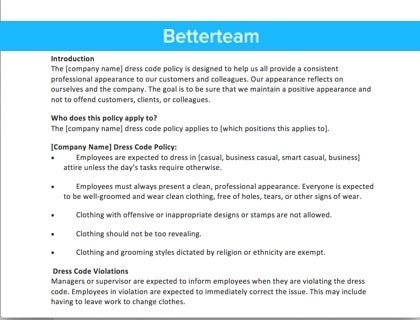
Disciplinary Policy Template Download:
Get our free disciplinary action policy for employees template in Word format and quickly adapt it to work for your company.
Download NowDisciplinary Action Policy Sample:
1. Policy overview.
[Company name]'s discipline policy explains the steps we will take to address employee failure to perform or misconduct. This policy applies to all [company name] employees.
2. At-will employment.
Although we may try to follow our discipline policy as outlined below, employees at [company name] work at-will, and can be terminated at any time, for any reason.
3. Progressive discipline steps.
Our disciplinary process can move through the following steps:
[List your steps here. You can see examples of the steps below.]
Managers or supervisors will document each step in this process using official forms. All forms must be filed with HR. Managers or supervisors must meet with HR before making decisions regarding steps 4 and 5.
Employees must always be informed of any disciplinary action, of what stage they are in, the consequences of further violations, and corrective actions they can take.
Steps may be repeated at the discretion of the manager or supervisor.
4. Explanation of the steps.
[Give a detailed explanation of each step. Find more info on this below.]
The [company name] progressive discipline plan may begin at any step, depending on the severity of the offense. For example, employee tardiness will begin at step 1, mistakes that cause major disruptions at work may begin at step 3. Fraud or other illegal or dangerous behavior may go directly to step 5.
The [company name] disciplinary policy is meant to provide guidelines.
5. Right to appeal.
Employees who believe they were not treated properly may appeal any disciplinary decisions with HR.
All information in this article is for informational purposes only. Consult with your HR department and/or attorney before making decisions on employee discipline.
Steps in a Progressive Discipline Process:
1. Verbal warning.
This is typically the first step in the discipline process. In this step, employees should receive verbal warnings in private. The exact nature of what took place and why it is in violation of policy, or how it falls short of performance expectations, should be explained, along with corrective actions. HR should be notified of the warning.
2. Formal written warning.
This is often the second step in the discipline process. In this step, the manager or supervisor should use a write-up form to describe the incident and corrective actions. The employee should read the form and sign that they received it.
3. Formal disciplinary meeting.
This is usually the third step in the discipline process. In this step the employee, manager/supervisor, and an HR representative meet to discuss the problem. HR investigates the problem. The employee is informed that after this point punitive action may take place, up to, and including termination.
4. Suspension or loss of privileges.
This is typically the fourth step in the discipline process. In this step, the employee may receive penalties, such as a loss of certain privileges, suspension from some or all duties, a demotion, or other appropriate penalties.
5. Termination.
This is usually the final step in the discipline process. In this step, the employee is fired for continued violations. The final decision to terminate will be approved by an HR representative after an investigation to ensure fairness.
Final Thoughts:
Having a company disciplinary policy in place will take away a lot of uncertainty from employees, and help ensure that your company or organization has a fair process that treats everyone equally.

